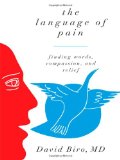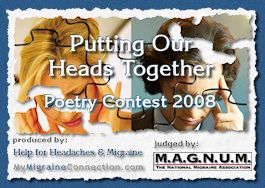 RSS FEED
RSS FEED
Posts Tagged ‘pain’
The Language of Pain – a review
August 29th, 2010
 I recently finished The Language of Pain, by David Biro, M.D. A practicing physician in Brooklyn, NY, Dr. Biro also has a PhD in literature. This interesting combination of educational disciplines, together with Dr. Biro’s own experience as a patient with a blood disorder, leads to his thoughtful and philosophical writing on the isolating experience of pain. I presume that his earlier book, One Hundred Days: My Unexpected Journey from Doctor to Patient must focus more specifically on his personal (and unexpected) experience in bridging those worlds. The Language of Pain is a more general and outer-focused book, discussing how profoundly isolating the experience of being in pain is (be it physical or emotional pain) and how important it is to find means of expressing the experience.
I recently finished The Language of Pain, by David Biro, M.D. A practicing physician in Brooklyn, NY, Dr. Biro also has a PhD in literature. This interesting combination of educational disciplines, together with Dr. Biro’s own experience as a patient with a blood disorder, leads to his thoughtful and philosophical writing on the isolating experience of pain. I presume that his earlier book, One Hundred Days: My Unexpected Journey from Doctor to Patient must focus more specifically on his personal (and unexpected) experience in bridging those worlds. The Language of Pain is a more general and outer-focused book, discussing how profoundly isolating the experience of being in pain is (be it physical or emotional pain) and how important it is to find means of expressing the experience.
The Language of Pain is an interesting read, pointing out that an understandable expression of the pain one experiences is necessary both to get proper treatment for the pain (or the underlying condition that causes the pain), and to keep people in pain from being isolated from their families, friends and community. Drawing on many examples from art and literature, Dr. Biro explores how metaphor enables us to take the diffuse experience of pain and put it in terms that others can understand. The book is illustrated with some of Frida Kahlo’s gripping paintings, as well as patient-generated works of art gathered by Deborah Padfield in a pain clinic in the UK, and other art. We read many passages from literature describing pain, disease, and bodily peril, from works by Tolstoy, London, Crane and Joyce, among others.
This is not a long book, but it took me a long time to finish. I found that some of the descriptions of pain were, well, painful for me to read. It may be that for one living with chronic pain, this book hits too close to home. Nor is it an easy read. His points are excellent, but perhaps Dr. Biro couId have expressed them in a more accessible manner. This may sound funny coming from me; an inveterate user of big words. I could have used less literary and philosophical analysis and more practical examples of how finding language for their pain has helped pain patients.
The book is subtitled “Finding words, compassion and relief.” Without doubt the writing is compassionate, and ignites the reader’s compassion. There was inspiration for me personally in the examples of words used to express pain; certainly I remembered them in my own moments of pain, and tried to be more conscious of expressing myself. It is the “relief” that I would like to have heard more of in the book. Maybe because relief from pain is something I long for in my own life, and for other sufferers. It wouldn’t be fair for me to fault Dr. Biro for not providing a magic wand! He pulls it all together very well in his postscript, stating:
More than just communicating one person’s experience, the metaphors of great writers contribute to our collective experience of pain. They add to our ever-growing repository of language, and to our ever-growing understanding of what it means to be human. Indeed, we should think of our great artists no differently than our great scientists. Both have profoundly practical goals; each works to help us understand and talk about what is not fully understood or communicable. But where the scientist shines his searchlight on the objective world, the artist strives to illuminate the subjective one.
One of the things that fascinates me most is the meeting and communication of our left and right brains, our analytical and intuitive sides, the scientist and artist in each of us. I love thinking about what having both an MD and a PhD in literature would bring to a person’s thinking and understanding of the world. Dr. Biro thank you, you have done an elegant job of sharing your thinking with us. I’ll expose my own prejudices as a coach when I ask, next book, would you give us a little more of how to use those two sides of the brain for relief in our own lives?
– Megan Oltman
To keep the FTC happy I will disclose that the publisher asked me if I might like to review the book in my blog, and sent me a free copy so that I might do so. They did not pay me to puff the book, and I won’t receive anything else from doing this review unless some of you decide to link in to Amazon and buy it there, which would net me a few pennies per book. The publisher has no doubt given up on me, as they sent me the book before it’s publication in January of this year.
Tags: chronic pain, David Biro MD, Deborah Padfield, Frida Kahlo, Jack London, James Joyce, Leo Tolstoy, living with pain, pain, Stephen Crane, The Language of Pain
Posted in Books, Communicating, Managing, Medicine | Comments (0)
Botox for Head Implosion, not Explosion?
February 17th, 2010
A new study of 18 Migraine sufferers reported in the Archives of Dermatology Monday indicates that Botox may be helpful for those who describe their pain as “crushing” or “eye-popping.” That’s an interesting new  distinction. So, not so good for those of us, like me, who walk around saying “My head explode!”
distinction. So, not so good for those of us, like me, who walk around saying “My head explode!”
It’s hard to say how significant a study of 18 patients is, and previous reports on Botox for Migraines have been mixed at best. This study reports an average reduction from 7 Migraines per month to 1 Migraine per month, among those who responded to the Botox. You can read a bit more about the study here: Does Botox Stop Some Migraines? in the Minneapolis – St. Paul Star Tribune. What really interests me, though, is the fact that the description of the pain itself is indicative of whether the Botox will help or not. Pain is so subjective, and so difficult to measure, it’s fascinating that there could be a correlation between how we experience the pain and the mechanics of our Migraines.
I’m imagining a time when you can describe your pain, and get a specific treatment for it. Head imploding? Try this. Head exploding? Try that. What about that one where little people with grapefruit spoons are trying to scrape your brain off the inside of your skull? I hate that one.
– Megan
Tags: Botox, migraine, Migraine treatment, pain
Posted in Current Affairs, Medicine, Musings | Comments (5)
How much Pain?
December 2nd, 2009
My daughter had her wisdom teeth out yesterday. Once the anesthesia wore off she started feeling pretty  serious pain. She took her first Lorcet and called me on the intercom about half an hour later, sounding panicked – she needed more pain meds, right now! We got her some ibuprofen, but tried to explain that the meds take a while to take effect, and to give it a chance. Today she is in bed with a swollen face, pain and nausea, quite miserable. We’re bringing the ice packs, the medications, the mushy food, and trying to comfort her the best we can.
serious pain. She took her first Lorcet and called me on the intercom about half an hour later, sounding panicked – she needed more pain meds, right now! We got her some ibuprofen, but tried to explain that the meds take a while to take effect, and to give it a chance. Today she is in bed with a swollen face, pain and nausea, quite miserable. We’re bringing the ice packs, the medications, the mushy food, and trying to comfort her the best we can.
I’ve been thinking about the nature of pain. At nineteen, my daughter has never had surgery before, never had a broken bone or other serious injury, and the only serious illness she has had was the chicken pox at age four. Her pain today is real and I can’t be the judge of how much pain she has. Her pain may be worse because unfamiliar. When I was her age, I had had: Migraines for at least six years, a broken arm, stitches on my face, major abdominal surgery, the mumps, the chicken pox, scarlet fever, the measles… Pain and I were old acquaintances (I won’t say friends). I have written before about how you never get used to pain. Pain is, in some ways, continuously and horribly new every time, every moment. But at the same time, pain can become familiar, and for that reason, perhaps less frightening.
 The most severe pain I can remember was when I broke and dislocated an elbow. I went into shock, I believe from the pain. Both my labors were quite painful, as I had an unproductive pattern of contractions, which came two or three in a row without pause, and each set didn’t do as much work as one normal contraction. Childbirth pains are different, I think, because any pain you experience is for something, something big and very important, and you know there is an end in sight. At twenty-nine I fell and herniated a disk and lived for years with nagging, stinging pain in my low back and right leg. I have also had Migraines where the pain was so intense I felt moment by moment as if I could not stand one moment more, where all I could do was rock myself and sob, to quote a Migraine buddy of mine. I also had my wisdom teeth out at twenty-two and I don’t remember how that pain compared, but I do remember two miserable and very drugged up days.
The most severe pain I can remember was when I broke and dislocated an elbow. I went into shock, I believe from the pain. Both my labors were quite painful, as I had an unproductive pattern of contractions, which came two or three in a row without pause, and each set didn’t do as much work as one normal contraction. Childbirth pains are different, I think, because any pain you experience is for something, something big and very important, and you know there is an end in sight. At twenty-nine I fell and herniated a disk and lived for years with nagging, stinging pain in my low back and right leg. I have also had Migraines where the pain was so intense I felt moment by moment as if I could not stand one moment more, where all I could do was rock myself and sob, to quote a Migraine buddy of mine. I also had my wisdom teeth out at twenty-two and I don’t remember how that pain compared, but I do remember two miserable and very drugged up days.
I have learned, though, that something changes when pain is familiar, when it is not mysterious. Yes, frequent severe pain is debilitating, exhausting, dis-enheartening beyond belief. But at the same time, with familiarity it can lose some of its power over us.
What do I mean by that? This is difficult to talk about. Pain is real, but at the same time our experience of it is subjective. It’s not “all in our heads” in the sense of being imagined. It is not produced by neurosis or by being weak or hysterical. But at the same time, we can change and effect our experience of pain. When my Migraines became very frequent, I learned a practice of deliberate relaxation, based in yoga, biofeedback and guided imagery. A part of the practice is to look at pain head on – to be very aware of the experience of pain. Not to fight it or try to pull away from it, but to meet it, recognize it, describe it and observe it. In that process we get some detachment from it. Sometimes we can reduce it significantly, or make it disappear. Even if that doesn’t happen, we can make it much easier to bear.
I teach these relaxation techniques to Migraineurs and others with chronic illnesses because I believe we can truly make a difference for ourselves when we learn to focus inward. I believe we should fight for better treatment, strive and work to understand and manage our own systems, but when faced with pain we must practice a kind of acceptance. I’m not talking about being a doormat or giving up. I am talking about looking the pain in the eye – saying yes, there it is, it feels like this, it is this much better or worse than any other pain, it is located here, it behaves like this. Observing it, allowing it to be and allowing it to fade.
I’m not saying this is easy. Don’t ever let anyone tell you you should “just” learn to live with it. There is no “just” about it – it’s hard and takes continual work. I use relaxation zealously in the tough times and then I slack off, and have to pick it back up and get back in practice when the next challenge comes along. Overall I have developed an awareness of my system and its ups and downs. I have less pain in my life, and the pain has less effect on me, than before I began these techniques.
There may be some kind of threshold level beyond which the rules change, or become distorted. I haven’t experienced really frequent or chronic severe pain. Six years ago my Migraine pattern suddenly increased, from a monthly menstrual Migraine plus one or two big ones a year, to three or four major Migraines a week. That was the closest I have come to experiencing truly chronic pain. And three or four times a week I felt something like the panic I heard in my daughter’s voice yesterday. Nowadays pain doesn’t panic me. I may get cranky and resentful, but sooner rather than later i say to myself, Okay here it is again. Be with what’s so, and do what I can to help it ease or pass.
I am learning a new kind of pain as I adjust to fibromyalgia. My body has become a pain amplifier, and a small pain can grow outward with ripples over a day or more until I hurt everywhere. I am having a flare-up today. I ache from head to toe. I am grateful that despite the allover aches, I don’t feel the constant severe pain I hear of from some with fibro. I am practicing what Migraines have taught me, to pace myself, to push only gently, to be with the pain, not to fight it, to know that this too shall pass.
I’m hoping for a better tomorrow, for me, for you, for my daughter. In the meantime, I will be with what’s so. My arms ache and I’m going to rest now.
– Megan
Wisdom tooth image courtesy of Steve Montgomery; broken elbow image courtesy of H Dragon.
Tags: fibromyalgia, Migraines, pain, pain levels, pain management, relaxation techniques, wisdom tooth extraction
Posted in Managing, Musings | Comments (3)
Don’t restrict Acetominophen – Educate, don’t Regulate
September 22nd, 2009
Please sign the American Pain Foundation‘s petition to the Food & Drug Administration asking them to educate the public about the dangers of overuse of acetominophen (Tylenol), rather than restricting its use. The FDA is considering banning pain medications such as Lortab, Percocet and Darvocet which contain acetominophen as a second ingredient in combination with a narcotic pain reliever, as well as making extra-strength acetominophen formulations available only by prescription. As the petition states,
When used as recommended, acetaminophen is a safe and effective pain reliever and fever reducer and has been used by millions of Americans for decades. This medicine, like all medicines, has risks when used beyond the recommended amounts.
Acetaminophen: Educate, Do Not Regulate.
The FDA’s proposed regulations are due to concerns about liver damage from overuse of acetominophen. Proper labeling could do away with much of this concern, and avoid leaving pain patients without medications they need to get by on a daily basis. Without proper labeling, it’s easy to overuse the medication even at lower doses. More importantly, people who rely on these medications to get through their daily lives will be left without help.
You can also leave comments directly for the FDA – the comment period ends September 30th.
Please take a few minutes to take action on this important issue!
– Megan
Tags: acetominophen, American Pain Foundation, FDA, pain
Posted in Advocacy, Managing, Medicine | Comments (0)
this time it doesn’t even rhyme
August 30th, 2008
Who’s that trying to remove my brain? 
Crack my skull and scoop it out like an egg?
Maybe they’re trying to get me to leave –
If they whack me on the temple a few more times
I might leave town, you never know.
Who’s that trying to remove my brain?
last week they tried grapefruit spoons –
serrated edges scraped my skull – is it sectioned inside like a fruit?
This week blunt instruments are in vogue
I wish they’d learn some anger management.
I wish they’d stop trying to remove my brain.
What did I ever do to them?
Maybe they don’t like silly poetry
Made up by a migraine-addled red-head.
They’re over-reacting, I swear.
There must be someone trying to remove my brain
I know they’re trying to remove my brain.
It hurts like they’re trying to remove my brain –
crack my skull with a nutcracker and pick out the meat
couldn’t just be my own neurons going nuts…
Could it?
– Megan
Coming to you from Migraine Central
Soft-boiled egg image courtesy of Sharon Mollerus; grapefruit image courtesy of x-eyedblonde; walnut image courtesy of Masayoshi Sekimura.
Tags: brain, migraine, pain, poetry
Posted in Silliness | Comments (2)
God Grant me the Serenity to Accept the Migraines I Cannot Change
July 11th, 2008
I try to live by the serenity prayer:
God grant me the serenity to accept the things I cannot change, the courage to change the things I can, and the wisdom to know the difference.
This simple prayer has seen me through family issues, recovery from major illness, life crisis and transitions, grief, job loss, financial difficulty. It is the mantra I repeat as the pain takes over my head, as I wait for my meds to work, as I practice deep breathing to relax my mind and body. It keeps me focussed where I need to be, in knowing what I can change and what I can’t, not wasting my energy where I cannot change something, not sitting in useless despair when there is something I can do. It also keeps me in the moment. I cannot change anything in the past. I can only change the future by taking the next right action to lead me where I want to go, not by wishing, hoping, fantasizing or sitting immobilized in fear.
There’s no way for me to write a post about spirituality without talking about what I believe, which is deeply personal and which I rarely discuss. I grew up with a Jewish mother (from a not very religious family) and a father who was the son of Presbyterian missionaries, celebrated holidays from both religions but was raised pretty much as an atheist, and then became a Quaker (along with most of my family) as a teenager. Spirituality and faith may never be a simple matter for me. I don’t consider myself a religious person, but I am a spiritual person.
There’s no way to write a post about spirituality, I think, without turning some of you off. Some may already be turned off by the use of the word “God.” Some were turned off by my description of my unusual religious background. Some will be excited by it and see it as an opportunity to convert me. Please resist that temptation! Some will be turned off in a moment when I tell you that I consider myself to be a faithful agnostic. What does that mean? I have faith in a power greater than myself, in a power for good, the power of love, a power that unites people, incites altruism, brings us to care for more than our own selfish interests, “that of God in every man.” I believe there is more out there than we can see, perceive or know in any scientific sense. But I’m… blessed if I know what it is! I don’t even think it’s important for me to know what it is!
 How does this help me with Migraine disease? I don’t go down the road of “God gave me Migraines for a reason.” Whatever else I believe, I can’t get behind the idea of a God who causes suffering, for any reason. I think more that we live in this gloriously complex world where we have sunsets and earthquakes, roses and poison ivy, kittens and sharks, senses of humor and migraines. It’s a complex system that somehow all works together, and we are part of it, warts and all. Migraines and all.
How does this help me with Migraine disease? I don’t go down the road of “God gave me Migraines for a reason.” Whatever else I believe, I can’t get behind the idea of a God who causes suffering, for any reason. I think more that we live in this gloriously complex world where we have sunsets and earthquakes, roses and poison ivy, kittens and sharks, senses of humor and migraines. It’s a complex system that somehow all works together, and we are part of it, warts and all. Migraines and all.
I do believe, though, in my God, my higher power, as a comforter. As the force of love, of good. To help me through pain, to help me remember that I am not the pain, that I am more than the disease, that I am here to help others, to make the world better. Sometimes in the midst of a migraine, I have a moment of feeling like this is all there is, no world exists outside the pain. I say the serenity prayer. It reminds me that there is more. That I am more. That another day will dawn when I am without pain and can get on with living. That the beauty of the world is still there waiting. I do think it takes faith to live with Migraine disease. Ridiculous faith and unconquerable hope. I am amazed by the ridiculous faith and unconquerable hope I see in my fellow migraineurs. And I find serenity there too.
– Megan
Wishing you serenity and freedom from pain
Tags: faith, Migraine disease, pain, serenity prayer, spirituality
Posted in Managing, Musings, Religion | Comments (8)
Happy Independence Day!
July 3rd, 2008
I’ll be at the beach tomorrow with my shades and big hat, so I wish you a Happy Independence Day in advance. I wish you independence from pain, from fear and from worry!
Here’s a 4th of July garden for you, with red & white impatiens and blue & white hydrangea, and some cool shade and warm sun.
Enjoy!
– Megan
Tags: garden, independence, pain
Posted in Musings | Comments (1)
Migraine Poetry
May 7th, 2008
 By now, I hope you’ve had a chance to read some of the wonderful poetry at the 2008 Putting Our Heads Together Migraine and Headache Poetry Contest. Congratulations again to all the winners. There were an enormous number of excellent entries – I don’t envy the judges!
By now, I hope you’ve had a chance to read some of the wonderful poetry at the 2008 Putting Our Heads Together Migraine and Headache Poetry Contest. Congratulations again to all the winners. There were an enormous number of excellent entries – I don’t envy the judges!
My own entry was way down the list. With your indulgence, I reprint it here.
Never Get Used to It
We never got used to the drunk next door
who broke bottles on the stoop past midnight, cussed all
night,
staggered into us as we left the apartment.
He was a feature of the landscape we were glad to leave
when we moved away.
Along with the upstairs landlords
whose children jumped off the couch above my head, all day,
while I napped with my newborn,
who thought 3 a.m. was a good time to install carpeting, KaChunk
KaChunk all night,
who coated the back yard in weed killer, fumes rolling into
our ground floor apartment – they were a feature of the landscape we never got
used to.
So we moved away.
We never got used to the dirty old busybody next door with
his nasty comments.
We never pulled up the blinds or trimmed the hedge on his
side of the house.
We just moved away. Again.
You’d think you’d get used to the pain – it’s a bore. There’s no excitement in pain.
Just the startled moment when it comes again, crashing like
the bottles on the stoop.
Just the deadly hours of enduring, KaChunk, KaChunk,
don’t pull up the blinds and let it look in.
Never get used to the scraping, boring, searing,
pounding.
Pain management?
I thought pain could recede, a feature of the landscape to
ignore, like the cracks in the pavement.
I never thought this was a landscape I could not move away
from.
No moving van. No
packing boxes.
No new home without the pain.
Open your boxes and find the drunken, staggering,
inconsiderate,
dirty old busybody pain.
No ear plugs. No gas
masks. No prisoners taken. No quarter given.
Never get used to it.
Megan Oltman
Broken Bottles image courtesy of Vertigogen Window Blinds image courtesy of Matt Callahan Packing Box image courtesy of Tim Herrick
Tags: migraine, pain, pain management, poetry
Posted in Communicating, Weblogs | Comments (4)
That disclaimer thing...
Remember: nothing we do here is medical advice or treatment or is a substitute for medical advice or treatment. Get competent medical advice to learn more about your migraines, possible treatments and risks.
What's New on Migraine Support Group Coaching |
Recent Comments
- on Calling all Redheaded Migraineurs
- on No, You’re not Crazy, You just Have Migraines
- on No, You’re not Crazy, You just Have Migraines

